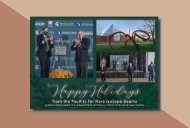202 FRIB Graduate Brochure
Create successful ePaper yourself
Turn your PDF publications into a flip-book with our unique Google optimized e-Paper software.
Kyle Brown<br />
Assistant Professor of Chemistry<br />
Keywords: Nuclear Reactions, Nuclear Structure, Neutron Stars, Equation of<br />
State<br />
Nuclear Chemistry<br />
About<br />
• BS, Chemistry, Indiana University, 2012<br />
• PhD, Nuclear Chemistry, Washington University in St.<br />
Louis, 2016<br />
• Joined the laboratory in 2016<br />
• brownk@frib.msu.edu<br />
Research<br />
Students in my group will use nuclear reactions to probe<br />
how nuclear matter assembles in systems ranging from<br />
nuclei to neutron stars. This work is split between two<br />
main concentrations: utilizing reactions to determine the<br />
nuclear equation of state and to probe the origin of the<br />
elements.<br />
After the groundbreaking measurement of a neutronstar<br />
merger two years ago, there has been a renewed<br />
interest in pinpointing the nuclear equation of state for<br />
matter about twice as dense as found in the middle of<br />
heavy nuclei. In particular, we seek to understand the<br />
density and momentum dependence of the symmetry<br />
energy. This is a repulsive term in the binding energy<br />
that arises from an imbalance in the numbers of protons<br />
and neutrons. Using heavy-ion collisions, my group can<br />
create these very dense environments in the laboratory,<br />
and by studying the particles that are ejected from the<br />
collision we can help determine the symmetry energy.<br />
the identity of the charged particle. These detectors are<br />
often paired with neutron detectors, gamma detectors,<br />
and/or the S800 spectrometer.<br />
Students in my group will take leading roles in the setup,<br />
execution, and analysis of these experiments. This can<br />
include design and testing of new detector systems,<br />
computer simulations of the experiment, or theoretical<br />
modeling depending on the interests of the student.<br />
Future experiments include using nuclear structure<br />
inputs to constrain the neutron skin in heavy nuclei,<br />
transfer reactions to study the origin of the elements,<br />
and measuring transverse and elliptical flow observables<br />
from heavy-ion collisions.<br />
Selected Publications<br />
First observation of unbound 11 O, the mirror of the halo<br />
nucleus 11 Li. T.B. Webb et al. PRL 112, 122501 (2019).<br />
Large longitudinal spin alignment generated in inelastic<br />
nuclear reactions. D.E.M. Hoff et al. PRC 97, 054605<br />
(2018).<br />
Observation of long-range three-body Coulomb effects<br />
in the decay of 16 Ne. K.W. Brown et al. PRL 113, 232501<br />
(2014).<br />
My second research focus is on probing the origin of the<br />
elements. All elements heavier than iron are made via<br />
proton or neutron capture reactions in explosive stellar<br />
environments, for example neutron-star mergers or x-ray<br />
bursts. Many of these reactions have extremely low cross<br />
sections and cannot be measured directly. Students in<br />
my group will use transfer reactions to measure the<br />
nuclear structure of these rare isotopes, to indirectly<br />
constrain their nucleon capture cross sections.<br />
These experiments are typically performed using small<br />
arrays of silicon and cesium-iodide detectors. Quite often<br />
we will use the High-Resolution Array (HiRA), which is a<br />
modular array of telescopes made of a combination of<br />
one to two silicon detectors followed by four cesiumiodide<br />
detectors arranged in quadrants behind them.<br />
These telescopes provide excellent energy and angular<br />
resolution, and the combination of detectors determines<br />
44<br />
<strong>202</strong>2_<strong>FRIB</strong>_<strong>Graduate</strong>_<strong>Brochure</strong>v4.indd 44<br />
10/29/<strong>202</strong>1 3:33:50 PM






